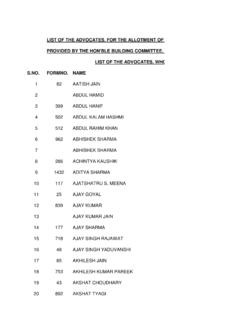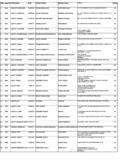Transcription of XAPP1082 (v5.0) July 16, 2018 Authors: Anil Kumar A V ...
1 XAPP1082 ( ) July 16, 2018 focus of this application note is on Ethernet peripherals in the Zynq -7000 SoC. This application note describes using the processing system (PS) based gigabit Ethernet MAC (GEM) through the extended multiplexed I/O (EMIO) interface with the 1000 BASE-X or SGMII physical interface using high-speed serial transceivers in programmable logic (PL). This application note also describes the implementation of PL-based Ethernet supporting jumbo frames. The designs provided with this application note enable the use of multiple Ethernet ports, and provide kernel-mode Linux device drivers. The reference design files for this application note can be downloaded from the xilinx website. For detailed information about the design files, see Reference Zynq-7000 SoC device integrates a dual core ARM Cortex -A9 MPCore based PS and PL in a single PL includes the programmable logic, configuration logic, and associated embedded devices.
2 The PS comprises the processor unit, on-chip memory, external memory interfaces, and peripheral connectivity interfaces including two gigabit ethernet controllers (GEM), which access PL signals through the extended multiplexed I/O (EMIO) interface to connect different physical interfaces. In the designs provided with this application note, the PS-GEM0 is connected to the Marvell PHY through the reduced gigabit media independent interface (RGMII), which is the default setup for the ZC706 board. The focus of this application note is the design of additional Ethernet designs described in this application note are: PS Ethernet (GEM1) that is connected to a 1000 BASE-X or SGMII physical interface in PL through an EMIO interface PL Ethernet implemented as soft logic in PL and connected to the 1000 BASE-X or SGMII physical interface in PLApplication Note: Zynq-7000 SoCXAPP1082 ( ) July 16, 2018PS and PL Ethernet Performance and Jumbo Frame Support with PL Ethernet in the Zynq-7000 SoCAuthors: Anil Kumar A V, Radhey Shyam Pandey and Naveen Kumar GaddipatiIntroductionXAPP1082 ( ) July 16, 2018 1 shows the various Ethernet implementations on the ZC706 :The three Ethernet links cannot be active at the same time because the ZC706 board offers only one SFP cage for the 1000 BASE-X or SGMII PHY.
3 The PS-GEM0 is always tied to the RGMII Marvell PHY. The PS-GEM1 and the PL Ethernet share the 1000 BASE-X or SGMII PHY so only two Ethernet Links can be active at a given time. The 1000 BASE-X/SGMII PHY and the GTX transceiver are part of the AXI Ethernet core for PL Ethernet Clock GenerationThe design uses the GTX transceiver X0Y10 on the Zynq-7000 SoC connected to the SFP cage on the ZC706 board for 1000 BASE-X or SGMII transceivers. The GTX transceiver reference clock (125 MHz differential) is generated from the Si5324 jitter attenuator on the ZC706 board. The clock divider values are adjusted to generate 125 MHz from the MHz crystal connected to the Si5324 driver programs the device over the I2C interface to generate the required clock value. This driver initializes the Si5324 once at boot time. At boot time, the driver probe function is invoked by the I2C framework. The probe function fetches the client address from the device tree and programs the hardware registers with the relevant values.
4 See [Ref 1] for details on Target - Figure 1 Figure 1:Zynq-7000 SoC Ethernet InterfaceAPUGIC32-bit GP AXI-Master64-bit HP AXI-SlavePL to Memory InterconnectMemory InterfaceUARTC entral InterconnectProcessing SystemDMAGEM0 MarvellRGMIIGMII to RGMIIMIOGMII Via EMIOGTXT ransceiverSFPAXI InterconnectAXI InterconnectAXI-DMAAXI-EthernetGMIIP rogrammable LogicPS-GEM0 LinkPS-GEM1 Link Via EMIOPL Ethernet Linkmacbmacbxilinx_axienet_main1000 BASE-X/SGMIIDMAGEM1X1082_01_102815 Using PS GEM Through EMIOXAPP1082 ( ) July 16, 2018 PS GEM Through EMIOThis section describes how to use the PS Ethernet block GEM1 with the PL PHY through the EMIO interface. The PS Ethernet block is exposed to the PL through the EMIO, GMII, and management data input/output (MDIO) interfaces. The 1 Ethernet PCS/PMA or SGMII core is used as Ethernet physical media in 1000 BASE-X or SGMII modes, and uses the high-speed serial transceivers to access the SFP cage on the ZC706 board.
5 The connection between the SFP cage to a standard Ethernet LAN is through an SFP-to-RJ45 converter DesignFigure 2 shows the design block diagram. The GMII interface connects the PHY and PS EMAC through the EMIO pins. The GEM1 block is enabled while generating the hardware system. See the Checksum Offloading section in the Gigabit Ethernet Controller chapter in [Ref 2] for information on checksum offloading in PS_GEM. See the chapter on using 1000 BASE-X or SGMII PHY with Zynq-7000 SoC in [Ref 3] for more Target - Figure 2 Figure 2:Design Block DiagramEthernet MAC(GEM1)MDIO1000 BASE-X PCS/PMA Or SGMIIGTGMII_TXGMII_RXSFPP rocessing SystemProgrammable LogicSi5324125 MHz GT Reference Clock GMII_TX_CLKGMII_RX_CLKMDCTCP/IP StackPS Ethernet DriverStandard Networking ApplicationSoftware Driver For LinuxDevice TreeLinux ImageX1082_02_040413 Using PS GEM Through EMIOXAPP1082 ( ) July 16, 2018 DesignThe design uses the common driver code for the PS- GEM0 and PS-GEM1.
6 To enable GEM1 through the EMIO interface, specific registers must be programmed. This is part of the PS configuration data used by the Zynq-7000 SoC first stage bootloader (FSBL). On system generation with the EMIO enabled for the second GEM, the file that is available on SDK export of the hardware design, includes the register settings by default, which are: To select the EMIO as the source of receive clock, data, and control signals:Set [SRCSEL] bit to 1 To select the EMIO as the source to generate reference clock:Set [SRCSEL] bit to 3 b1xxwhere x is don t care (can be either 1 or 0)The macb driver uses the DMA controller attached to the GEM Ethernet controller in the PS. This driver is responsible for several functions, including DMA descriptor rings setup, allocation, and recycling. The interrupt handling is done only for the PS GEM events, as the interrupt status implicitly reflects the DMA events as well.
7 Additionally, the device tree is updated to include PS-GEM1 with relevant :To support other PL physical interfaces, such as TBI, the hardware design and device tree must be edited. The PHY specific initialization is handled in the phylib subsystem in the Linux driver (macb) and information regarding the PHY can be provided in the device tree. To use the phylib subsystem for PHY programming, the phylib subsystem must support the PHY initialization routine for the desired PS GEM Through EMIOXAPP1082 ( ) July 16, 2018 DriverA monolithic Linux device driver is provided for this design. Figure 3 shows the software architecture for the PS Ethernet Target - Figure 3 Figure 3:Software Architecture PS Ethernet InterfacesUser LevelLinux KernelEthernet DriverHardwareGIC (Intr Controller)Ethernet TransmitDMA ChannelEthernet & DMA(finish, done, halt, error events)MII InterfaceReceive OverflowTransmit OverflowTransmit DMAR eceive DMAGMII PHYD river ModuleTransmit ISRT ransmit TaskletTransmit Top HalfReceive ISRR eceive TaskletReceive Top Halfproc interfacedev interfaceSchedulerSoft IRQ/proc /devDo IRQMII PHYmdio_readmdio_writemdio_resetadjust_l inkDMA AccessTX BD Ring managementRX BD Ring managementETHTOOL HooksGet/Set settingsGet drv infoGet LinkGet /Set WOLethtool supportPHY LibraryX1082_03_032113 Using PL EthernetXAPP1082 ( ) July 16, 2018 PL EthernetThis section describes a PL implementation of Ethernet.
8 The design consists of the AXI Ethernet, AXI DMA, and AXI Interconnect IP cores. The AXI Ethernet IP is connected to the 1000 BASE-X or SGMII PHY. The design uses the high performance (HP) port for fast access to the PS-DDR memory, however, the general purpose slave port can also be used if the HP port is occupied with other DesignFigure 4 shows the block diagram for the Ethernet implementation in HP port is used for fast data transfers between the PL and the PS DDR3 memory. It connects to the AXI DMA scatter-gather, stream to memory mapped (S2MM), and memory mapped to stream (MM2S) interfaces through the AXI interconnect. This interconnect also performs data-width conversion to connect the 64-bit HP port to the 32-bit interfaces of AXI DMA. In the AXI DMA, both the scatter-gather option and data realignment engine are enabled for the S2MM and MM2S Target - Figure 4 Figure 4:PL Ethernet Design Block DiagramAPUGIC32-bit GP AXI-Master64-bit HP AXI-SlavePL to Memory InterconnectMemory InterfaceDDR3 AXI InterconnectAXI InterconnectAXI-DMAAXI-EthernetRXTXS2 MMMM2S125 MHz GT Reference Clock UARTC entral InterconnectClock GenerationProcessing SystemProgrammable LogicTCP/IP StackEthernet Driver (AXI DMA + AXI Ethernet)Standard Networking ApplicationSoftware Driver For Linux1000 BASE-X/SGMII InterfaceSi5324 SFP75 MHz (FCLK1)Device TreeLinux ImageGTX TransceiverX1082_04_113015 Using PL EthernetXAPP1082 ( ) July 16, 2018 streaming interface of the AXI DMA is connected to the AXI Ethernet subsystem.
9 The AXI Ethernet subsystem has full checksum offloading (CSO) enabled and has FIFO depths of 16K to support jumbo frame AXI Ethernet core implements an Ethernet MAC and supports 1000 BASE-X and SGMII PHY interfaces. It connects to the SFP through GTX transceivers through 1000 Base-X/SGMII the control interface, a general-purpose AXI master port is enabled in the PS. This port connects to the AXI DMA and AXI Ethernet cores. The 1000 BASE-X or SGMII PHY registers are accessed using the MDIO interface provided through the AXI Ethernet interrupt ports from the AXI DMA and the AXI Ethernet IPs are connected to the general interrupt controller (GIC) in the :For further details on the IP cores, see [Ref 3], [Ref 4], and [Ref 5].Software DesignThis section describes the software aspects of the monolithic Linux driver code facilitates the functionality listed here: PL Ethernet MAC accesses AXI DMA transfers Physical media initialization for 1000 BASE-X or SGMII interface using the phylib subsystemAbout Device TreesXAPP1082 ( ) July 16, 2018 DriverFigure 5 shows the software architecture for the driver is divided into these sections (see Appendix A for more information): Initialization MAC driver hooks Interrupt service routinesAbout Device TreesThe Device Tree is a data structure for describing hardware.
10 Rather than hard coding every detail of a device into an operating system, many aspects of the hardware can be described in a data structure that is passed to the operating system at boot time. These settings are parsed by the drivers at the time of loading and parameters are set as defined in the device Linux drivers device trees consist of: PS Ethernet MAC EMIO-specific: PS GEM1 section, containing PS MAC parameters. PL Ethernet-specific:X-Ref Target - Figure 5 Figure 5:Driver Architecture for PL EthernetUser LevelLinux KernelEthernet DriverHardwareGIC (Intr Controller)Ethernet TransmitDMA ChannelEthernet & DMA(finish, done, halt, error events)MII InterfaceReceive OverflowTransmit OverflowTransmit DMAR eceive DMAGMII PHYD river ModuleTransmit ISRR eceive ISRDMA AccessMII PHYproc interfacedev interfaceSchedulerSoft IRQ/proc /devDo IRQX1082_05_040713 Hardware RequirementsXAPP1082 ( ) July 16, 2018 DMA section, containing AXI DMA parameters.
















